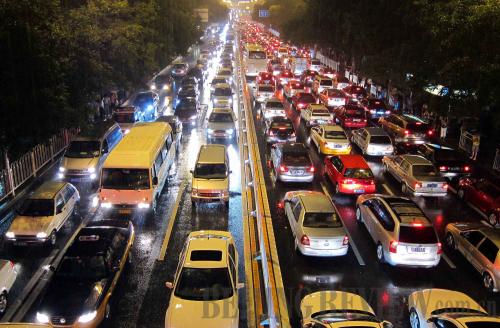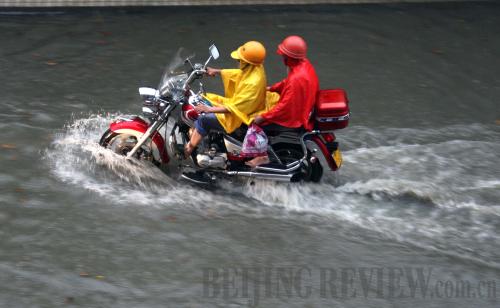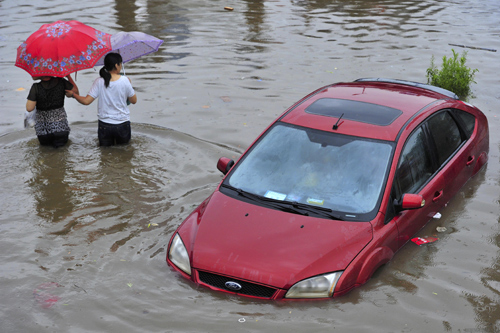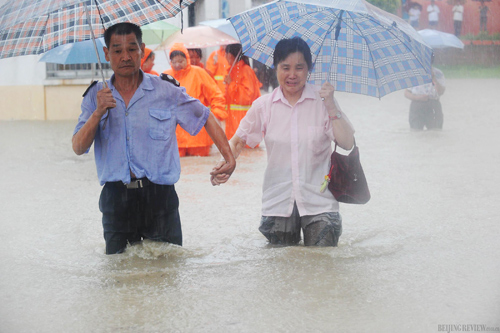|
|

|

|
|
LOGGED TRAFFIC: Vehicles move slowly on Shijingshan Road in Beijing on June 23 (GONG LEI) |
FIGHTING THROUGH THE FLOOD: Two citizens ride a motorcycle on a flooded road in Chengdu, Sichuan Province on July 3 (XUE YUBIN) |
|

|

|
|
WATER MARK: A car is stranded in the water in Changsha, Hunan Province on June 28 (CFP) |
UNEXPECTED SWIM: Two people have a hard time getting home in Hefei, Anhui Province on July 11 (XINHUA) |
Several overpasses and major roads were inundated by the downpour. National broadcaster CCTV reported at 8:30 p.m. that 42 intersections had been completely submerged. The water level was estimated to have reached 1.5 meters near Lianhuaqiao.
Waterlogged roads slowed and even stopped traffic in some downtown areas and created gridlock on highways. Outbound and inbound vehicles lined up in seemingly endless queues near the capital's peripheral ring roads. According to the Beijing Traffic Management Bureau, 76 bus routes were also affected by the flooding.
The rain also wreaked havoc on operations of Line 1, Line 13 and Yizhuang Line of the city's subway. Transportation on parts of Line 1 and Line 13 was temporarily halted.
Confronted with such massive disruption and gridlocked traffic many people chose to forego vehicles altogether. "Walking is faster than any other means, and many people got out of buses and taxis to walk home," a CCTV report said.
The rain also grounded flights at the Beijing Capital International Airport. According to a statement on the airport's website, 144 flights were canceled and 93 flights were delayed for more than an hour.
Such extensive disruption at the capital's main airport had a ripple effect that could be felt throughout the country, and with a sudden loss of connecting flights many other airports also suffered paralysis.
While the economic cost to the city in terms of the effects of the delays and disruption was high, most unfortunately the rain also took a toll in human life.
In Shijingshan District, rushing waters dislodged a drainage cover and two men in their 20s were sucked into the drainage system. One fell as he tried to push a stalled car out of the flood, while the other fell as he tried to save his colleague.
Both men were migrant workers at a home decoration company. Their bodies were found on June 25.
After the chaos and the floodwaters subsided many Beijing residents found comfort in an especially dark sense of humor and the Internet was flooded with quips and comments.
"If you love her, bring her to see the sea in Beijing's Forbidden City," said a post on Sina.com's micro-blogging site.
Someone else joked, "It took hundreds of years for Venice to become a romantic city of water, while Beijing became an Asian Venice after just a few hours of rain."
A picture showing drain water backing up into the Taoranting Station on Subway Line 4 was forwarded more than 35,000 times and received more than 5,000 feedback messages by June 24.
"The most romantic thing in the world is watching the waterfall in Beijing's subway with you," said an Internet user in a message to accompany the photo.
Many Internet users blamed Beijing's weak drainage system for the massive disruption, saying the emergency had revealed the inadequacy of the city's drainage facilities.
Conscience of the cities
Wuhan, situated on the middle reaches of the Yangtze River, China's longest waterway, has long been associated with water. However, the torrential rains on June 18 flooded most of its major streets. The water level at 82 intersections reached 50 mm. And on Xinhuaxia Road in Hankou the water level exceeded 2 meters, trapping several people on their way home.
Water levels in the city were such that 1,200 relief workers were called in to help drain flooded areas. Within 24 hours these workers drained 19.48 million cubic meters of water, using firefighters' pumps.
On June 24, another significant rainstorm hit Wuhan and again dozens of intersections were flooded. As in Beijing, the city's drainage system has been blamed for the disastrous situation.
Though China has battled floods throughout its long history, urban flooding has become a particularly serious issue over the past few decades, as the country continues to urbanize and cities become ever more congested.
While cities like Wuhan and Nanjing in Jiangsu Province, situated on the middle and lower reaches of the Yangtze River, have long been known for flooding, many other cities have become flood prone in recent years.
| 